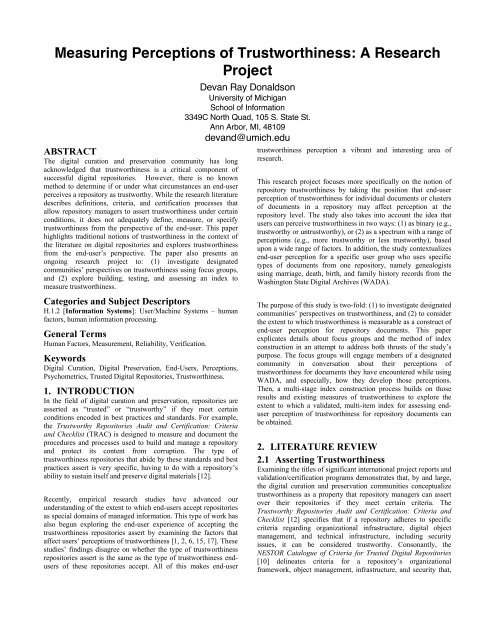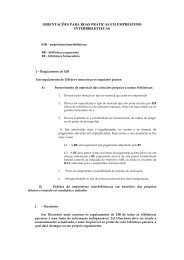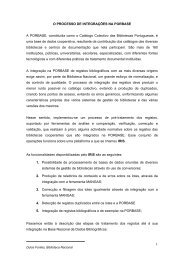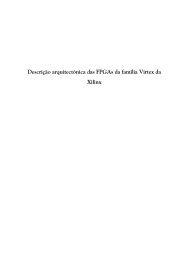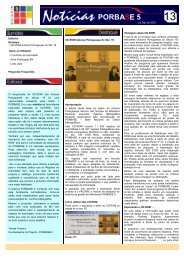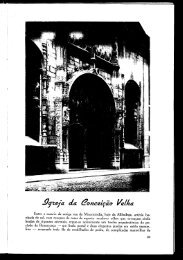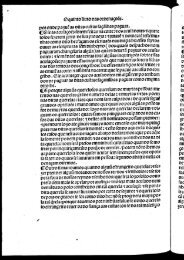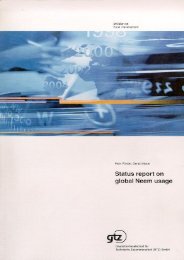Measuring Perceptions of Trustworthiness: A Research Project
Measuring Perceptions of Trustworthiness: A Research Project
Measuring Perceptions of Trustworthiness: A Research Project
You also want an ePaper? Increase the reach of your titles
YUMPU automatically turns print PDFs into web optimized ePapers that Google loves.
<strong>Measuring</strong> <strong>Perceptions</strong> <strong>of</strong> <strong>Trustworthiness</strong>: A <strong>Research</strong><br />
<strong>Project</strong><br />
ABSTRACT<br />
The digital curation and preservation community has long<br />
acknowledged that trustworthiness is a critical component <strong>of</strong><br />
successful digital repositories. However, there is no known<br />
method to determine if or under what circumstances an end-user<br />
perceives a repository as trustworthy. While the research literature<br />
describes definitions, criteria, and certification processes that<br />
allow repository managers to assert trustworthiness under certain<br />
conditions, it does not adequately define, measure, or specify<br />
trustworthiness from the perspective <strong>of</strong> the end-user. This paper<br />
highlights traditional notions <strong>of</strong> trustworthiness in the context <strong>of</strong><br />
the literature on digital repositories and explores trustworthiness<br />
from the end-user’s perspective. The paper also presents an<br />
ongoing research project to: (1) investigate designated<br />
communities’ perspectives on trustworthiness using focus groups,<br />
and (2) explore building, testing, and assessing an index to<br />
measure trustworthiness.<br />
Categories and Subject Descriptors<br />
H.1.2 [Information Systems]: User/Machine Systems – human<br />
factors, human information processing.<br />
General Terms<br />
Human Factors, Measurement, Reliability, Verification.<br />
Keywords<br />
Digital Curation, Digital Preservation, End-Users, <strong>Perceptions</strong>,<br />
Psychometrics, Trusted Digital Repositories, <strong>Trustworthiness</strong>.<br />
1. INTRODUCTION<br />
In the field <strong>of</strong> digital curation and preservation, repositories are<br />
asserted as “trusted” or “trustworthy” if they meet certain<br />
conditions encoded in best practices and standards. For example,<br />
the Trustworthy Repositories Audit and Certification: Criteria<br />
and Checklist (TRAC) is designed to measure and document the<br />
procedures and processes used to build and manage a repository<br />
and protect its content from corruption. The type <strong>of</strong><br />
trustworthiness repositories that abide by these standards and best<br />
practices assert is very specific, having to do with a repository’s<br />
ability to sustain itself and preserve digital materials [12].<br />
Recently, empirical research studies have advanced our<br />
understanding <strong>of</strong> the extent to which end-users accept repositories<br />
as special domains <strong>of</strong> managed information. This type <strong>of</strong> work has<br />
also begun exploring the end-user experience <strong>of</strong> accepting the<br />
trustworthiness repositories assert by examining the factors that<br />
affect users’ perceptions <strong>of</strong> trustworthiness [1, 2, 6, 15, 17]. These<br />
studies’ findings disagree on whether the type <strong>of</strong> trustworthiness<br />
repositories assert is the same as the type <strong>of</strong> trustworthiness endusers<br />
<strong>of</strong> these repositories accept. All <strong>of</strong> this makes end-user<br />
Devan Ray Donaldson<br />
University <strong>of</strong> Michigan<br />
School <strong>of</strong> Information<br />
3349C North Quad, 105 S. State St.<br />
Ann Arbor, MI, 48109<br />
devand@umich.edu<br />
trustworthiness perception a vibrant and interesting area <strong>of</strong><br />
research.<br />
This research project focuses more specifically on the notion <strong>of</strong><br />
repository trustworthiness by taking the position that end-user<br />
perception <strong>of</strong> trustworthiness for individual documents or clusters<br />
<strong>of</strong> documents in a repository may affect perception at the<br />
repository level. The study also takes into account the idea that<br />
users can perceive trustworthiness in two ways: (1) as binary (e.g.,<br />
trustworthy or untrustworthy), or (2) as a spectrum with a range <strong>of</strong><br />
perceptions (e.g., more trustworthy or less trustworthy), based<br />
upon a wide range <strong>of</strong> factors. In addition, the study contextualizes<br />
end-user perception for a specific user group who uses specific<br />
types <strong>of</strong> documents from one repository, namely genealogists<br />
using marriage, death, birth, and family history records from the<br />
Washington State Digital Archives (WADA).<br />
The purpose <strong>of</strong> this study is two-fold: (1) to investigate designated<br />
communities’ perspectives on trustworthiness, and (2) to consider<br />
the extent to which trustworthiness is measurable as a construct <strong>of</strong><br />
end-user perception for repository documents. This paper<br />
explicates details about focus groups and the method <strong>of</strong> index<br />
construction in an attempt to address both thrusts <strong>of</strong> the study’s<br />
purpose. The focus groups will engage members <strong>of</strong> a designated<br />
community in conversation about their perceptions <strong>of</strong><br />
trustworthiness for documents they have encountered while using<br />
WADA, and especially, how they develop those perceptions.<br />
Then, a multi-stage index construction process builds on those<br />
results and existing measures <strong>of</strong> trustworthiness to explore the<br />
extent to which a validated, multi-item index for assessing enduser<br />
perception <strong>of</strong> trustworthiness for repository documents can<br />
be obtained.<br />
2. LITERATURE REVIEW<br />
2.1 Asserting <strong>Trustworthiness</strong><br />
Examining the titles <strong>of</strong> significant international project reports and<br />
validation/certification programs demonstrates that, by and large,<br />
the digital curation and preservation communities conceptualize<br />
trustworthiness as a property that repository managers can assert<br />
over their repositories if they meet certain criteria. The<br />
Trustworthy Repositories Audit and Certification: Criteria and<br />
Checklist [12] specifies that if a repository adheres to specific<br />
criteria regarding organizational infrastructure, digital object<br />
management, and technical infrastructure, including security<br />
issues, it can be considered trustworthy. Consonantly, the<br />
NESTOR Catalogue <strong>of</strong> Criteria for Trusted Digital Repositories<br />
[10] delineates criteria for a repository’s organizational<br />
framework, object management, infrastructure, and security that,
if met, result in repositories attaining trusted status. The Digital<br />
Repository Audit Method Based on Risk Assessment<br />
(DRAMBORA) [5] notes that if a repository identifies and<br />
properly manages threats to preserving digital materials, it can be<br />
considered trustworthy. The Data Archiving and Networked<br />
Services (DANS) – Data Seal <strong>of</strong> Approval (DSA) [7] outlines<br />
guidelines for the data producer, data consumer, and data<br />
repository that, if met, allow a repository to emboss an actual seal<br />
<strong>of</strong> approval on its website as an attestation <strong>of</strong> its trustworthiness.<br />
Similar to the other guidelines/standards, “[t]he seal <strong>of</strong> approval<br />
does not express any views regarding the quality <strong>of</strong> the data to be<br />
archived, but does regarding the provisions an archive has made<br />
to guarantee the safety and future usability <strong>of</strong> the data” [7, n.p.].<br />
Often, the type <strong>of</strong> trustworthiness that repositories (which abide<br />
by these standards and best practices) assert focuses on a<br />
repository’s ability to sustain itself and preserve digital materials.<br />
2.2 Factors Affecting End-User<br />
<strong>Trustworthiness</strong> Perception<br />
Despite differences in the type <strong>of</strong> repository, the type <strong>of</strong> content<br />
used, the type <strong>of</strong> user, and the purpose for using content from a<br />
repository, existing empirical research on trustworthiness<br />
perception for end-users <strong>of</strong> digital repositories suggests that a<br />
variety <strong>of</strong> factors affect their perception at both repository and<br />
document levels. Specifically, at the repository level, prior<br />
experience, institutional/organizational reputation, and third party<br />
endorsement are among the factors that affect end-user<br />
trustworthiness perception. At the document level, the<br />
author/creator/producer <strong>of</strong> the information, peer review,<br />
institutional/organizational reputation, a document or dataset’s<br />
presence in a repository, and use purpose are among the factors<br />
that affect end-user perception <strong>of</strong> trustworthiness. In addition,<br />
findings vary regarding the extent to which repository level<br />
trustworthiness perception interacts with trustworthiness<br />
perception at the document level.<br />
2.2.1 Factors Affecting End-User <strong>Trustworthiness</strong><br />
Perception at the Repository Level<br />
A user’s prior experience with a repository is a factor that can<br />
help in determining the trustworthiness <strong>of</strong> a repository. St. Jean et<br />
al. [15] found that end-users base their perceptions <strong>of</strong> whether a<br />
repository is trustworthy on their prior experience with that<br />
repository. Specifically, the findings suggest that the more<br />
positive experiences end-users have with repositories, the more<br />
trustworthy they perceive those repositories to be. Likewise,<br />
participants in the Conway [2, p. 455] study perceived the<br />
repository they dealt with as trustworthy because <strong>of</strong> having<br />
“consistently positive experience in obtaining relevant, useful, and<br />
technically appropriate” content.<br />
institutional reputation as compared to archaeologists.<br />
Furthermore, novice quantitative social scientists were twice as<br />
likely to mention the importance <strong>of</strong> institutional reputation as<br />
expert quantitative social scientists.<br />
Users’ first-hand experiences are seemingly more important to<br />
their perceptions <strong>of</strong> trustworthiness than external factors like<br />
certification. While in their study, Ross and McHugh [13] took as<br />
axiomatic that certification is one marker that helps users<br />
determine the trustworthiness <strong>of</strong> a repository, subsequent studies<br />
that collected data from actual users <strong>of</strong> digital repositories show<br />
that third party endorsement might not be key in determining the<br />
trustworthiness <strong>of</strong> a repository. For example, the CASPAR<br />
Consortium [1] found that users <strong>of</strong> curated digital objects rated the<br />
fact that a repository has been validated by a toolkit such as<br />
DRAMBORA or TRAC and the fact that a repository has been<br />
validated by a domain-specific authority such as the Museums<br />
Documentation Association (MDA) among the least important<br />
factors in determining the trustworthiness <strong>of</strong> a repository.<br />
Similarly, in the Yakel et al. [17] study, only one quantitative<br />
social scientist cited seals <strong>of</strong> approval, a form <strong>of</strong> third party<br />
endorsement, as a factor that positively influences trustworthiness<br />
perception.<br />
2.2.2 Factors Affecting End-User <strong>Trustworthiness</strong><br />
Perception at the Document Level<br />
Across multiple studies, the importance <strong>of</strong> the<br />
author/creator/producer <strong>of</strong> the content is an important factor for<br />
some end-users in determining the trustworthiness <strong>of</strong> repository<br />
content. For example, faculty, library staff, museum staff,<br />
undergraduate and graduate students in the St. Jean et al. [15]<br />
study were concerned about who created the content and why.<br />
People engaged in environmental planning including pr<strong>of</strong>essionals<br />
employed by state, local, and federal agencies, representatives <strong>of</strong><br />
environmental organizations and industry, concerned residents,<br />
and landowners in the Van House et al. [16, p. 340] study wanted<br />
not only to know who created the content, but to understand the<br />
extent to which the creator “followed the appropriate scientific<br />
practices” as part <strong>of</strong> their determination <strong>of</strong> the “trustability” <strong>of</strong> a<br />
dataset. Study participants also indicated that they needed to know<br />
the reputation <strong>of</strong> the content creator in order to determine the<br />
trustability <strong>of</strong> a measurement dataset. In contrast, in the Fear and<br />
Donaldson [6] study, awareness <strong>of</strong> a content creator’s reputation<br />
was insufficient grounds for perceiving a dataset as trustworthy.<br />
According to the faculty members, postdoctoral<br />
fellows/researchers, staff scientists, and consultants in the study,<br />
some scientists with good reputations make “crap data” available<br />
while some other relatively unknown scientists create very<br />
trustworthy data.<br />
In addition to their own experience with repositories, users<br />
consider others’ experiences as well, via the repository’s<br />
reputation or track record. The CASPAR Consortium [1] found<br />
that users <strong>of</strong> curated digital objects rated the track record <strong>of</strong> a<br />
repository’s ability to curate objects the most important factor<br />
among sixteen others in determining if a repository is trustworthy.<br />
Similarly, Yakel et al. [17] found that both archaeologists and<br />
quantitative social scientists mentioned institutional reputation as<br />
an important trustworthiness factor. Specifically, quantitative<br />
social scientists were twice as likely to mention the importance <strong>of</strong><br />
Prior research suggests that if some end-users assume or know<br />
content has been subject to peer review, they will perceive that<br />
content as more trustworthy than they would otherwise. For<br />
example, in the St. Jean et al. [15] study, some faculty, library<br />
staff, museum staff, undergraduate and graduate students<br />
perceived institutional repository content as more trustworthy<br />
because they were under the impression that the content was<br />
subject to some sort <strong>of</strong> peer review process. In the Fear and<br />
Donaldson [6] study, the faculty members, postdoctoral<br />
fellows/researchers, staff scientists, and consultants were aware <strong>of</strong><br />
the fact that not all the datasets in the proteomics repository had
een subject to peer review. In response, study participants<br />
actively sought out datasets that were associated with published<br />
articles and perceived those datasets as more trustworthy than<br />
other datasets that were unassociated with publications. The<br />
reason the study participants had such positive trustworthiness<br />
perceptions for datasets that were associated with publications<br />
was because, in the field <strong>of</strong> proteomics, both publications and<br />
their associated data are peer reviewed. In contrast to some <strong>of</strong> the<br />
other studies, the repository under investigation in the Van House<br />
et al. [16] study housed unpublished material and the study<br />
participants understood that the content had not been peer<br />
reviewed. Thus, participants did not rely on peer review to serve<br />
as a heuristic for perceiving content encountered within the<br />
repository as either trustworthy or untrustworthy, as some<br />
respondents in the St. Jean et al. [15] study assumed they could, or<br />
as some participants in the Fear and Donaldson [6] study actually<br />
could.<br />
In the St. Jean et al. [15] study, faculty, library staff, museum<br />
staff, undergraduate and graduate students indicated that a<br />
repository’s tie with an institution positively influences their<br />
perceptions about the trustworthiness <strong>of</strong> the content they find.<br />
They assumed that an institution would not allow information that<br />
was untrustworthy to be made available via the repository,<br />
because they assumed the institution would not jeopardize its own<br />
reputation by providing untrustworthy information.<br />
For some end-users, the presence <strong>of</strong> a dataset in a repository<br />
serves as an indication <strong>of</strong> its trustworthiness. Fear and Donaldson<br />
[6] found that some proteomics researchers believe that a<br />
scientist’s willingness to make his or her data available in a<br />
repository demonstrates that it is trustworthy enough to be used by<br />
others. These study participants subscribed to the idea that data<br />
producers would not willingly make untrustworthy data available<br />
because doing so could jeopardize a data producer’s reputation.<br />
Levy [9] first pointed out that the use to which digital documents<br />
will be put is an important consideration that should guide choices<br />
about digital preservation. Subsequent empirical research suggests<br />
that use purpose is moderated by end-user trustworthiness<br />
perception for documents preserved in a repository. For example,<br />
in the Fear and Donaldson [6] study, participants perceived some<br />
<strong>of</strong> the preserved datasets as trustworthy enough to replicate the<br />
analysis <strong>of</strong> the data creator, but those same data were not<br />
perceived as trustworthy enough to actually understand the<br />
biology behind the data, and were thus insufficient for that use<br />
purpose.<br />
2.3 The Interaction <strong>of</strong> Repository and<br />
Document Level <strong>Trustworthiness</strong> Perception<br />
Results vary regarding the extent to which repository and<br />
document trustworthiness perceptions interact. Conway [2, p. 455]<br />
found that, for his study participants, trustworthiness “ascends to<br />
the organizational level and, as a consequence, pervades the<br />
resources delivered digitally.” In contrast, Yakel et al. [17, p. 11]<br />
found that “[t]rust in the repository is a separate and distinct factor<br />
from trust in the data.” Taken together, the findings motivate a<br />
need for more research to better understand when repository<br />
trustworthiness perceptions affect document trustworthiness<br />
perceptions, and when they do not.<br />
2.4 End-User Conceptualization <strong>of</strong><br />
<strong>Trustworthiness</strong><br />
In the St. Jean et al. [15] study, repository end-users articulate<br />
their conceptualization <strong>of</strong> trustworthiness in a way that suggests it<br />
is multi-faceted for them. They interpreted “trustworthy” as<br />
comprehensive, factual, legitimate, pr<strong>of</strong>essional, reliable,<br />
reputable, updated, and verifiable.<br />
2.5 Summary <strong>of</strong> Literature as Motivation for<br />
Study<br />
Taken together, the literature demonstrates that trustworthiness is<br />
central to justification for digital repositories, but it has only been<br />
asserted as a concept. <strong>Trustworthiness</strong> has not been defined in a<br />
way that is amenable to verifying its presence or absence in a<br />
repository context from the end-user’s perspective. The research<br />
on end-users has identified factors that affect their perception <strong>of</strong><br />
trustworthiness at both repository and document levels. These<br />
findings provide insight into assumptions end-users make about<br />
the type <strong>of</strong> trustworthiness repositories assert. Existing empirical<br />
research also suggests that end-user conceptualization <strong>of</strong><br />
trustworthiness is multi-faceted [15]. For any repository,<br />
understanding how their designated communities conceptualize<br />
trustworthiness is necessary, as is measuring trustworthiness<br />
perception based upon that conceptualization. This paper<br />
describes the development <strong>of</strong> a composite measure for assessing<br />
designated communities’ concept <strong>of</strong> trustworthiness.<br />
3. A RESEARCH PROJECT<br />
3.1 The Washington State Digital Archives<br />
(WADA) as the Primary Site <strong>of</strong> Study<br />
The research study centers on end-user perception <strong>of</strong><br />
trustworthiness for preserved documents found in digital<br />
repositories. In order to conduct the investigation, the Washington<br />
State Digital Archives (WADA) will serve as the primary site <strong>of</strong><br />
study for five reasons. First, WADA is a highly utilized digital<br />
cultural heritage resource. Approximately 500,000 people visit<br />
WADA per year with thousands <strong>of</strong> unique visitors per month.<br />
Second, WADA has a strong and explicit mission statement,<br />
which focuses on making preserved digital information accessible<br />
to users. Third, WADA has had a great deal <strong>of</strong> success in<br />
administering web surveys to their users. Fourth, the author can<br />
access WADA data relatively seamlessly because <strong>of</strong> an<br />
established relationship with WADA administrators. Fifth, in<br />
action and deed, WADA is a Trusted Digital Repository (TDR)<br />
that abides by leading practices and standards for organizational<br />
infrastructure, digital object management, and technical<br />
infrastructure, including security issues, consistent with TRAC<br />
specifications, despite not being formally certified as a TDR as <strong>of</strong><br />
April 2013.<br />
This study focuses on genealogists, who represent WADA’s<br />
largest designated community (personal communication with<br />
WADA staff, March 8, 2013). Also, based on WADA’s download<br />
statistics, genealogical records are among WADA’s most highly<br />
downloaded records. For these designated community members,<br />
most <strong>of</strong> the records they utilize are digitized records available for<br />
download in JPEG format accompanied by transcriptions. In some<br />
cases, only the digitized record is available, and in other cases,<br />
only the transcribed version is available.
3.2 Focus Groups<br />
Before attempting to build, test, and assess an index to measure<br />
the construct <strong>of</strong> trustworthiness, one must understand designated<br />
communities’ perspectives on trustworthiness. According to<br />
Stewart and Shamdasani [14], one <strong>of</strong> the uses <strong>of</strong> focus groups is to<br />
learn about how respondents talk about a phenomenon. The<br />
research study will use focus groups to collect data from<br />
genealogists to understand their perspectives on trustworthiness.<br />
To recruit participants, WADA staff will forward a<br />
description/invitation for the study to users who they know have a<br />
track record <strong>of</strong> using WADA. Those interested will utilize the<br />
contact information provided in the study description to call or<br />
email the author directly and finalize arrangements for<br />
participating in the focus groups. The target size <strong>of</strong> each focus<br />
group is six to eight participants.<br />
Each participant will take a paper-based pre-survey before the<br />
focus group begins. It will include the following<br />
questions/prompts:<br />
1. On average, how frequently do you use the Internet?<br />
2. How strongly do you agree with the following<br />
statement: In general, I trust information I find on the<br />
Internet.<br />
3. In the last year, how frequently have you used the<br />
Washington State Digital Archives?<br />
4. What is your primary reason for visiting the Washington<br />
State Digital Archives?<br />
5. How strongly do you agree with the following<br />
statement: I usually find the documents I’m looking for<br />
when using WADA.<br />
6. How strongly do you trust the documents you find when<br />
using the Washington State Digital Archives?<br />
7. How satisfied are you with the way the Washington<br />
State Digital Archives displays documents?<br />
Question 1 engages participants’ Internet usage. Question 2<br />
examines participants’ disposition to trust information found on<br />
the Internet broadly speaking. Question 3 is useful for<br />
understanding the extent to which the study participants have a<br />
track record <strong>of</strong> using WADA. Question 4 focuses on participants’<br />
primary reason for using WADA. Questions 5-7 investigate<br />
participants’ experiences with and perceptions <strong>of</strong> WADA<br />
documents. In addition, the pre-survey includes two demographic<br />
questions related to participants’ age and gender.<br />
To maximize breadth and depth <strong>of</strong> discussion in the focus groups,<br />
the author will ask the following open-ended questions/prompts:<br />
1. Discuss the nature <strong>of</strong> the documents you use when using<br />
WADA and your purpose(s) for using them.<br />
2. Discuss your perceptions <strong>of</strong> trustworthiness for the<br />
documents you find using WADA.<br />
3. How would you describe a document you found in<br />
WADA that you think is trustworthy?<br />
4. Under what circumstances would you question the<br />
trustworthiness <strong>of</strong> a document you encountered while<br />
using WADA?<br />
5. Card-sorting exercise.<br />
Question 1 is designed to be an “icebreaker” question, which,<br />
according to Stewart and Shamdasani [14], is how any focus<br />
group should begin. The question engages participants’ use <strong>of</strong><br />
WADA, including their purposes. Questions 2-4 specifically<br />
engage trustworthiness in the context <strong>of</strong> WADA and for<br />
documents encountered within it. Question 5 is a card-sorting<br />
exercise in which participants will break into pairs and sort<br />
potential trustworthiness perception attributes into three piles in<br />
terms <strong>of</strong> how important they think they are for the documents they<br />
use: important, somewhat important, and not important. After<br />
participants complete the card-sorting exercise, we will discuss<br />
how and why each pair grouped the attributes the way they did.<br />
The focus groups will take place on-site at WADA and be<br />
videotaped. Each focus group will last for approximately an hour<br />
and a half. The resulting data will be transcribed and analyzed<br />
using nVivo 9.0. Overall, the focus groups will inform our<br />
understanding <strong>of</strong> these designated community members’<br />
perspectives on trustworthiness, including their conceptualization<br />
<strong>of</strong> the construct, laying the groundwork for the next phase <strong>of</strong> the<br />
research project.<br />
3.3 The Index Construction Process<br />
There are four steps to an index construction project, including:<br />
(1) construct definition, (2) generating an item pool, (3) designing<br />
the index, and (4) full administration and item analysis [4].<br />
3.3.1 Implementing Step 1 – Construct Definition<br />
Step 1 involves completion <strong>of</strong> three tasks related to defining<br />
trustworthiness. First, development <strong>of</strong> a brief definition <strong>of</strong><br />
trustworthiness, including its scope and any subcomponents that<br />
are to be included. Second, further development <strong>of</strong> the definition<br />
<strong>of</strong> trustworthiness by drawing upon existing definitions from<br />
relevant research studies and theoretical literature published in<br />
digital preservation and curation, communication studies,<br />
information science, and web credibility domains. Third,<br />
operationalization <strong>of</strong> the construct definition <strong>of</strong> trustworthiness<br />
by: (1) considering the different types <strong>of</strong> questions or rating scales<br />
to which study participants can respond, and (2) asking oneself<br />
what kinds <strong>of</strong> responses would be clear indicators <strong>of</strong> the<br />
respondents’ levels or amounts <strong>of</strong> perceived trustworthiness.<br />
3.3.2 Implementing Step 2 – Generating an Item<br />
Pool<br />
To implement Step 2, a number <strong>of</strong> tasks will be completed related<br />
to generating an item pool for the construct <strong>of</strong> trustworthiness.<br />
Any existing instruments that measure trustworthiness will be<br />
examined. Items from those instruments will be selected as a<br />
starting point for the initial item pool. If these instruments do not<br />
exist, related instruments will be examined, which may contain<br />
items that are acceptable for inclusion. If no items in existing or<br />
related instruments are appropriate, the researcher will create<br />
them. In addition, ideas for items will be gathered from reviewing<br />
the literature on trustworthiness. Items will also be generated from<br />
members <strong>of</strong> WADA’s largest designated community (i.e.,<br />
genealogists) who will be asked to articulate, during the focus<br />
groups, adjectives to describe documents they think are<br />
trustworthy. These trustworthiness attributes will be reviewed to<br />
assess the extent to which they compare or contrast with: (1) items<br />
found in the literature, and (2) items experts recommend.
By manual inspection, pretesting with a small sample <strong>of</strong><br />
respondents, and conferring with experts, a host <strong>of</strong> issues that<br />
must be considered during Step 2 will be addressed, which<br />
include [4]:<br />
• ensuring each item expresses only one idea<br />
• avoiding lack <strong>of</strong> colloquialisms, expressions, and<br />
jargon<br />
• ensuring the reading difficulty matches the reading<br />
level <strong>of</strong> respondents<br />
• ensuring the items match the specificity <strong>of</strong><br />
trustworthiness<br />
• ensuring that what the items have in common is<br />
trustworthiness and not merely a category<br />
• ensuring that the item pool consists <strong>of</strong> an exhaustive<br />
list <strong>of</strong> items that appear to fit trustworthiness<br />
• avoiding exceptionally lengthy items<br />
• making items as short and as uncomplicated as<br />
possible.<br />
Expert involvement will play a major role in Step 2. The<br />
researcher will assemble a panel <strong>of</strong> trustworthiness experts to<br />
evaluate the entire initial item pool. In a self-administered web<br />
survey, the experts will be provided the construct definition<br />
developed during Step 1 and then they will be provided with the<br />
initial item pool. The survey instructions will ask the experts to<br />
rate each item with respect to trustworthiness according to the<br />
following designations: essential, useful but not essential, or not<br />
necessary. Experts’ responses will be analyzed by computing a<br />
Content Validity Ratio (CVR) for each item [8]. For purposes <strong>of</strong><br />
this study, all items that have positive CVRs will be retained for<br />
the trustworthiness item pool. In addition, the instrument will ask<br />
experts to: comment on individual items as they see fit, evaluate<br />
the items’ clarity and conciseness, point out awkward or<br />
confusing items, suggest alternative wordings, and suggest<br />
additional items.<br />
3.3.3 Implementing Step 3 – Designing the Index<br />
Step 3 involves a number <strong>of</strong> activities related to the format <strong>of</strong> the<br />
index, including: selection <strong>of</strong> response categories and choices,<br />
writing item stems, and writing instructions. This step also<br />
involves pretesting.<br />
The definition <strong>of</strong> trustworthiness developed during Step 1,<br />
coupled with the researcher’s understanding <strong>of</strong> the literature on<br />
index construction for Step 3, will guide selection <strong>of</strong> response<br />
categories and choices.<br />
Following the recommendation <strong>of</strong> authors on the topic <strong>of</strong> index<br />
construction [4], the researcher anticipates choosing seven<br />
response choices. This odd number <strong>of</strong> choices will allow<br />
respondents the option <strong>of</strong> neutrality if particular items are neither<br />
important nor unimportant to them. In addition, seven response<br />
options will allow a greater level <strong>of</strong> granularity with respect to the<br />
resulting data. The various gradations <strong>of</strong> importance will enable<br />
the researcher to discover if and to what degree items are<br />
important or unimportant to end-users.<br />
Item stems will be written with the construct <strong>of</strong> trustworthiness in<br />
mind. As well, item stems will be written with the response<br />
categories in mind; they will be made as clear, concise,<br />
unambiguous, and concrete as possible.<br />
The item pool instrument will be administered as a web survey<br />
because WADA end-users are geographically dispersed. Thus,<br />
administering the item pool instrument as a web survey would<br />
make it much more feasible for respondents to participate in the<br />
project.<br />
Step 3 will also include informal pretesting and formal pilot<br />
testing <strong>of</strong> the draft instrument including cognitive interviews. For<br />
the informal pretesting, members <strong>of</strong> the Archives <strong>Research</strong> Group<br />
(ARG) at the University <strong>of</strong> Michigan School <strong>of</strong> Information will<br />
be recruited and emails will be sent out on student listservs to<br />
recruit Master’s and Ph.D. students. Each participant will be asked<br />
to indicate if any items are ambiguous or confusing, or if they feel<br />
any items cannot be rated along the response categories and<br />
choices provided by the instrument. The index will be revised on<br />
the basis <strong>of</strong> participants’ feedback. For the formal pilot testing, the<br />
researcher will travel to Washington to administer the index to a<br />
small group <strong>of</strong> actual WADA end-users, which WADA staff will<br />
help identify and recruit. Each respondent will complete the<br />
instrument in a private setting in the WADA Reading Room while<br />
the researcher is present. Each respondent will be asked to think<br />
aloud. Similar to the pretest participants, the pilot test participants<br />
will also be asked to indicate which items are ambiguous or<br />
confusing, and which items cannot be rated along the instrument’s<br />
response categories and choices. This type <strong>of</strong> evaluation will be<br />
used to identify items that are not clear, items that are being<br />
interpreted in ways that are different from how they were<br />
intended, as well as instructions that are vague or ambiguous.<br />
3.3.4 Implementing Step 4 – Full Administration and<br />
Item Analysis<br />
To implement Step 4, the item pool generated during Step 2 and<br />
pretested in Step 3 will be administered as an instrument and item<br />
analysis and factor analysis will be conducted. After each<br />
statistical test, the results will be used to further improve the<br />
instrument, deleting or revising any items that are not contributing<br />
to its quality. This iterative process will continue until the<br />
instrument is <strong>of</strong> sufficient quality.<br />
The sample population for this study will be actual WADA endusers<br />
from its largest designated community. The instrument will<br />
be administered to these users as an intercept survey [3]. For<br />
example, every 200 th visitor will receive a pop-up invitation to<br />
participate in the study. This form <strong>of</strong> probabilistic sampling (i.e.,<br />
systematic sampling) is a practically viable way <strong>of</strong> making sure<br />
actual WADA end-users participate randomly in the survey. In<br />
addition, screening questions will enable the researcher to identify<br />
those participants who self-report as genealogists.<br />
The number <strong>of</strong> participants for the study will be a function <strong>of</strong> the<br />
number <strong>of</strong> items in the instrument. Specifically, the researcher<br />
will follow Nunnally’s [11] recommendation <strong>of</strong> between 4 and 10<br />
participants per item.<br />
After administering the instrument to a sample <strong>of</strong> WADA endusers,<br />
several characteristics <strong>of</strong> individual items will be evaluated.
During item analysis, the researcher will examine item-scale<br />
correlations, item variances, and item means.<br />
To assess intercorrelation, the researcher will compute item-index<br />
correlations for each item. Corrected item-index correlation will<br />
be computed, rather than uncorrected item-index correlation<br />
because the latter could inflate reliability [4]. The researcher will<br />
also assess item variances by examining the range <strong>of</strong> responses for<br />
each item, anticipating retaining response items broadly, per<br />
DeVellis’s [4] recommendation.<br />
Both item-index correlations and coefficient alpha will be used to<br />
choose items for an index. Depending on the findings, a series <strong>of</strong><br />
steps may be taken, such as deleting some items, checking alpha,<br />
deleting more items, and rechecking alpha, until a final set <strong>of</strong><br />
items is chosen.<br />
During factor analysis, varimax rotation will be conducted and<br />
scree plots will be generated, paying close attention to those<br />
factors which have the highest eigenvalues. The results <strong>of</strong> the<br />
factor analysis will be examined to see if they make logical sense<br />
or make sense in light <strong>of</strong> existing theory.<br />
Although item-index correlations may be used from a statistical<br />
perspective to understand the extent to which certain items relate<br />
and could therefore be useful for measuring trustworthiness,<br />
results <strong>of</strong> statistical analyses will not be relied upon solely to build<br />
the index. The researcher will consider theoretical and practical<br />
understanding <strong>of</strong> the items in light <strong>of</strong> statistical calculations prior<br />
to finalizing conclusions about what is being measured.<br />
After administering the item pool as an instrument and completing<br />
item analysis and factor analysis on the data, a modified version<br />
<strong>of</strong> the index may be administered to another sample <strong>of</strong> WADA<br />
end-users, performing item analysis and factor analysis on the<br />
resulting data. The goal <strong>of</strong> Step 4 is to achieve an internally<br />
consistent and logically sensible instrument. Administering a<br />
modified version <strong>of</strong> the index may or may not be necessary. It will<br />
be dependent on results <strong>of</strong> the first item analysis and factor<br />
analysis; the researcher’s subjective judgment; and consultation<br />
with specialists with expertise in researching trustworthiness<br />
regarding whether the items the statistics suggest correlate make<br />
sense to be considered together.<br />
4. CONCLUSION & SIGNIFICANCE<br />
The research project is significant because it attempts to answer<br />
one <strong>of</strong> the most important questions in the digital curation and<br />
preservation research domain, “When is a repository<br />
trustworthy?” Specifically, the study is designed to:<br />
• explore what trustworthiness means to actual end-users<br />
• operationalize trustworthiness, and<br />
• measure trustworthiness.<br />
There is value in conducting this study regardless <strong>of</strong> the outcome.<br />
If completion <strong>of</strong> Steps 1 through 4 result in an internally<br />
consistent and logically sensible instrument, then the instrument’s<br />
mere existence validates claims by researchers that complex<br />
constructs cannot be measured reliably using one item [8], and<br />
that trustworthiness is no exception. Further, the instrument will<br />
provide a specific composite operationalization <strong>of</strong> the construct <strong>of</strong><br />
trustworthiness which could be tested for validity in various<br />
contexts, such as with documents found in TDRs besides WADA.<br />
If completion <strong>of</strong> Steps 1 through 4 does not result in an internally<br />
consistent and logically sensible instrument, substantial insight<br />
will be discovered concerning the challenges to measuring<br />
trustworthiness. This specific outcome would suggest that more<br />
conceptual work needs to be done on trustworthiness.<br />
Ultimately, investigating and measuring trustworthiness is<br />
precisely the type <strong>of</strong> work digital curation and preservation<br />
researchers need to conduct to understand and monitor designated<br />
communities’ perceptions <strong>of</strong> trustworthiness for repositories. This<br />
paper describes an ongoing research project with a methodology<br />
to administer such a process. The timeframe for this project is<br />
approximately one year from start to finish and is broken into four<br />
main phases: Step 1 (February 1, 2013 – April 30, 2013), Step 2<br />
including focus groups (May 1, 2013 – July 31, 2013), Step 3<br />
(August 1, 2013 – August 31, 2013), Step 4 (September 1, 2013 –<br />
November 30, 2013), data analysis and report writing.<br />
5. ACKNOWLEDGMENTS<br />
This material is based upon work supported by a Graduate Student<br />
<strong>Research</strong> Grant from the Horace H. Rackham School <strong>of</strong> Graduate<br />
Studies at the University <strong>of</strong> Michigan. The author would like to<br />
thank Paul Conway, Kathleen Fear, William Jacoby, James<br />
Lepkowski, Soo Young Rieh, Charles Senteio, and Elizabeth<br />
Yakel for providing comments on previous drafts <strong>of</strong> this paper, as<br />
well as Terence S. Badger and the staff at the Washington State<br />
Digital Archives for their help and support.<br />
6. REFERENCES<br />
[1] CASPAR Consortium. 2009. Report on Trusted Digital<br />
Repositories. Technical Report.<br />
[2] Conway, P. 2010. Modes <strong>of</strong> seeing: Digitized photographic<br />
archives and the experienced user. American Archivist 73(2):<br />
425-462.<br />
[3] Couper, M. P. 2000. Review: Web surveys: A review <strong>of</strong><br />
issues and approaches. Public Opin. Q. 64(4): 464-494.<br />
[4] DeVellis, R. F. 2012. Scale development: Theory and<br />
applications. Thousand Oaks, Calif.: SAGE.<br />
[5] Digital Curation Centre and Digital Preservation Europe.<br />
2007. DCC and DPE Digital Repository Audit Method Based<br />
on Risk Assessment, v.1.0. Technical Report.<br />
[6] Fear, K. and Donaldson, D. R. 2012. Provenance and<br />
Credibility in Scientific Data Repositories. Archival Science<br />
13(1): 55-83.<br />
[7] Harmsen, H. 2008. Data seal <strong>of</strong> approval - assessment and<br />
review <strong>of</strong> the quality <strong>of</strong> operations for research data<br />
repositories. Proceedings <strong>of</strong> the Fifth International<br />
Conference on Preservation <strong>of</strong> Digital Objects (St. Pancras,<br />
London, Sept. 29-30, 2008). iPres’08. 1-3.<br />
[8] Kim, Y. 2009. Validation <strong>of</strong> psychometric research<br />
instruments: The case <strong>of</strong> information science. J. Am. Soc. Inf.<br />
Sci. Technol. 60(6): 1178-1191.
[9] Levy, D. M. 1998. Heroic measures: Reflections on the<br />
possibility and purpose <strong>of</strong> digital preservation. Proceedings<br />
<strong>of</strong> the Third ACM Conference on Digital Libraries<br />
(Pittsburgh, Pennsylvania, USA). DL’98.<br />
[10] NESTOR Working Group on Trusted Repositories<br />
Certification. 2009. Catalogue <strong>of</strong> criteria for trusted digital<br />
repositories Version 2. Deutsche Nationalbibliothek:<br />
NESTOR Working Group.<br />
[11] Nunnally, J. C. 1978. Psychometric theory. New York:<br />
McGraw-Hill.<br />
[12] RLG-NARA Digital Repository Certification Task Force.<br />
2007. Trustworthy repositories audit and certification:<br />
Criteria and checklist. OCLC and CRL.<br />
[13] Ross, S., & McHugh, A. 2006. The role <strong>of</strong> evidence in<br />
establishing trust in repositories. D-Lib Magazine 12(7/8).<br />
[14] Stewart, D. W., and Shamdasani, P. N. 1990. Focus groups:<br />
Theory and Practice. Applied Social <strong>Research</strong> Methods<br />
Series; v. 20. Newbury Park, Calif.: Sage.<br />
[15] St. Jean, B., Rieh, S. Y., Yakel, E., and Markey, K. 2011.<br />
Unheard voices: Institutional repository end-users. College &<br />
<strong>Research</strong> Libraries 72(1), 21-42.<br />
[16] Van House, N., Butler, M. H., and Schiff, L. R. 1998.<br />
Cooperative Knowledge Work and Practices <strong>of</strong> Trust:<br />
Sharing Environmental Planning Data Sets. Proceedings <strong>of</strong><br />
the 1998 ACM Conference on Computer Supported<br />
Cooperative Work (Seattle, Washington, USA). CSCW’98.<br />
[17] Yakel, E., Faniel, I., Kriesberg, A., and Yoon, A.<br />
Forthcoming. Trust in Digital Repositories. International<br />
Journal <strong>of</strong> Digital Curation.


